
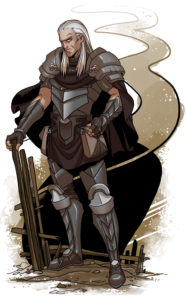
|
The Sidhe Lands – Nyara
Nyara is the capital of what remains of the once powerful sidhe empire. The City holds separate sectors for each of the surviving sidhe clans but common grounds in the central plaza for the market grounds, the Healer Guild’s tower, the Magistry tower a, d the Council Chambers. While the sidhe controlled much of the continent as recently as four generations past, their current land is split between the collective of the sidhe clans and the plains held by Ythelen’s people. The plains are largely barren and uninhabitable thanks to the fallout from the clan wars, so most sidhe call Nyara and the surrounding area home. Having developed an aversion to the ocean (except for the sea-faring Yappari, or perhaps because of them), Nyara is landlocked. Its water supply comes from one main river and its tributaries, distributed to all corners of the land through aqueducts.
History and Society
Until four generations prior to present times, sidhe society was separated into twelve clans with distinct cultures, deities, and beliefs. Most had loosely held alliances with one another and got along relatively well. Matches arranged between houses were common-place, cementing common interests and military might. At some point, however (accounts vary), war broke out between all the clans. Divided into two main factions they battled ruthlessly against one another. The exception was Ythelen and her plains-people, who objected to taking a side in the conflict and chose to remain neutral.
As skirmishes had broken out in the past, it might have been that a peace could have been achieved through concessions and new alliances – however, that was not to be. In what the sidhe subsequently termed the Winter Year, tensions escalated quickly; both sides brought in the aid of highly trained battle mages to manipulate the weather and the world’s base energies. When that proved to be insufficient more drastic measures were taken: technology was developed by the First Engineers, an elite group of magic wielders, to subjugate magic itself. Channeling the captive energy through the Hidden Engine they brought about an onslaught of unpredictable magical creations. No longer was magic a borrowing of power from primordial elements or a manipulation of existing natural phenomena; the sidhe set out to create artificial constructs to use as army fodder and weapons against their enemies. The most lethal of these were the Winterborn, followed by the subservient Shades. Magic is not one to be enslaved however and rebelled violently against its captors. The Winterborn went berserk and laid waste to entire cities, the shades drove mad the mages that created them… and the backlash from the magic spent re-animated the bodies of the fallen into an amalgam of flesh and vegetation, the Dreamers.
With a common enemy in the form of the monsters they had unwittingly unleashed, survivors of all sidhe clans joined in alliance against them.
Eventually, most sidhe deities sacrificed themselves in order to sap magic out of the world almost entirely. This left the constructs without the energy needed to continue, and the sidhe were victorious.
Decimated to a tenth of their populations, most of their survivors joined into a new sidhe collective. Within the collective Clan lines no longer as relevant. The only clans to opt out of the collective were Ythelen’s plains-people and the people that followed The Nameless. A third deity lays dormant and provides the remnants of his power to Nyara and its general sidhe population.
It should also be noted that sidhe population is in decline; children are few and far in between, and most are born without any magical abilities whatsoever. Should a child show magical ability he still has to be able to survive the triggering of his/her own magical ability during puberty, a process that claims the lives of many. Those that survive are bound by the marks of that magic as to the type of magic they will be able to use, and highly regulated by the Questors. |
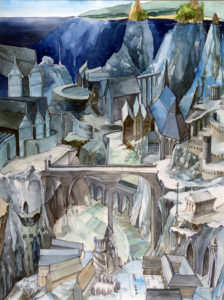
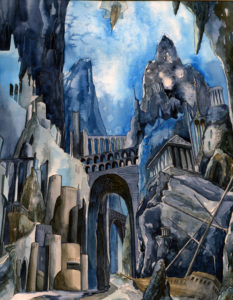
|
THE YAPPARI EMPIRE
When the sidhe splinter group first separated from the mainland sidhe they wanted a complete break from their past.Moving away from the settled lands of the clans they chose instead to make their way to the vast ocean that surrounds the Sidhe Empire, the Merchant states and everything in between. The capital of the Yappari is known as the Jeweled City. Its sprawling architecture is peppered with temples and walkways, while underwater gardens and avenues encircle the grounds of the Twelve Houses. It is of importance to note that Househeads treat these twelve official Houses as the symbol of their power and the seat of government. Here they entertain petitions and grievances and bring them to the Council. The council building itself is the most imposing structure in the city and is connected to every official House by an intricate walkway.
The rest of the empire has a less structured series of underwater cities and settlements, usually linked to an existing island or atoll above water. Most of the dwellings on dry land are carefully kept as a training ground; they also hold the homes were mates were traditionally kept in the past, as many were unable to live underwater.
History and Society
Yappari society is a matriarchy borne out of necessity. While the initial sidhe splinter group that became the Yappari had members of both sexes many of the men died in the first few years. Worried about dying out they took to the practice of mate hunting – raiding other sidhe clans and land-dwelling humans in order to bring additional males to the Empire.
The practice lasted only a generation, but it had lasting consequences both on Yappari society and on how they were perceived by their neighboring societies. The balance of power shifted drastically to the female members of the group, making the houses intrinsically matrilineal. In an effort to continue the inheritance lines while minimizing the danger of inbreeding the women were encouraged to take several lovers in lieu of a monogamous partnership. In time there was no such thing as a partnership, as men were relegated to their roles in procreation and as the network of support and service providers in the empire.
While the mate-hunting practice came to an end with the Sidhe- Yappari treaty negotiated by their current Matron, Iona, the gender inequalities continue. Much of the current unrest in the empire has to do with Matron’s resolve to do away with the traditional second-rate status of males within their society, something not all Yappari house-heads (or their followers) are willing to undertake. |
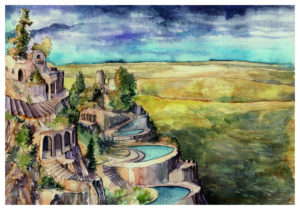 |
The Plainslands- Vaassillgaard
The plainslands were once the jewel of the sidhe empire, but were laid to waste during the clan wars. As sidhe and magical constructs to the war to their doorstep, their land was made fallow, changing their lifestyle forever. The land was saturated with so much tainted magical energy that nothing can grow in the plains anymore, lest it become a Dreamer. Because of this, the plains-land sidhe had become largely nomadic; the only city still standing is the stone fortress at Vaassillgaard, the seat of Ythelen’s power.
History and Society
Charged with acting as a shield between such creatures and their sidhe and human neighbors, the plains sidhe are largely nomadic. They are also the only mainland sidhe to still have a goddess- Ythelen is very much a part of their life and culture. As they have since the beginning of their history they honour her with a living avatar, a messenger of her will.
In addition, there is a seer an interpreter of her signs, one of the few sidhe able to manipulate magic. |
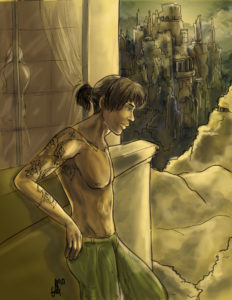 |
DragonKeep (The Sidhe Archives)
Strictly speaking, Dragonkeep and the library of sidhe archives isn’t in sidhe territory. The fortress houses the repository of sidhe knowledge and records in a large circular library; it also houses its keeper, Quinne. Dragonkeep was initially that home of one of the older sidhe clans situated in a particularly desolate landscape in the mountains. It stands on a ridge that separates the coastal human lands from the plains-lands, and it was one of the last buffers against the onslaught of the original Dreamers.
History
After the clan wars, it was left deserted as its people moved away to the central sidhe lands, particularly Nyara. It wasn’t entirely, however, because it housed the one other deity left alive, even if dormant. Because of the cocoon of magical energy still attached to the place, it was decided it was the safest place to keep all lore and magical artifacts; there they could be studied and catalogued without being in the vicinity of everyday sidhe.
Out of necessity its keeper has to fit a certain profile, and a significant ability to manipulate and control magic. The last known steward of Dragonkeep was Aristophe’s son, Quinne. |